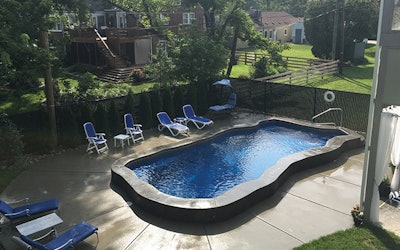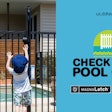
{bglink 4680}In 2006, fiberglass pools accounted for 8 percent of inground residential pool sales, according to P.K. Data. In 2015 that market share rose to 16 percent.
Although that apparent doubling in market share comes with caveat — the P.K. Data numbers are based on sales in areas requiring pool permits, which necessarily excludes large market regions where permits are not required — there is ample evidence of a surge in fiberglass popularity.
"We can look at numbers and see that the demand has doubled over the last 10 years," says installer Jason Hughes of River Pools and Spas (Warsaw, Va.). "What we're seeing is that the demand is more consumer-driven than builder-driven. So builders are responding to the demand for fiberglass pools that's coming from the marketplace. Consumers have greater access to information than they've ever had and the product and its benefits have evolved dramatically in recent years."
NEW TO THE SHELL GAME
Where customers are going, builders follow. One builder who last year began offering fiberglass pools, Dan Lenz of All Seasons Pools & Spas (Orland Park, Ill.), moved into fiberglass precisely because of burgeoning consumer demand.
"Here in the Midwest there's been an overall increase in demand for the product," Lenz says. "We've had more people walking through our door asking for fiberglass. In the past when we've been selling against fiberglass, trying to persuade people toward vinyl or gunite, some of them have walked back out the door because we weren't offering what they wanted. Those are customers that don't come back."
Lenz reports that his company had been considering the move for the past few years and eventually established ties with manufacturer San Juan Pools. Not only was that decision based on face-to-face contact with prospective buyers, but also on online inquiries and web analytics. "There have been a couple of significant builders in our area installing fiberglass pools for the past couple years, and during that time we've seen an exponential increase in searches and inquires for fiberglass," he says.
RELATED: 5 Common Fiberglass Concerns, Addressed
While the surge in interest has motivated some builders to adopt fiberglass, Curt Prystupa of Sun Pools (Brooksville, Fla.) says changes on the supply side of the industry have helped pave the way.
"One of the things that's happened is that fiberglass pool availability to builders has increased," he says. "They're now being sold through distributors in many areas and it's easier for builders to access a range of products. So it's easier for many to give them a try."
In most cases, he adds, builders are moving incrementally into the market, a process that could unfold over years. "I don't think builders are forgetting where they came from," he says. "They are still offering the traditional choices, but we do know that more and more are keeping an eye on fiberglass. They're realizing that it's to their benefit to offer fiberglass as an option."
"As an industry, we can be pretty slow to change," Hughes observes. "But more consumers are exposed to the product now, and for many, there might not be anyone in their area that offers fiberglass pools. So, they go to their local pool builders and start petitioning them because they're interested in the benefits."
DRIVING DEMAND
Those benefits, both to the consumer and the installer, are why fiberglass proponents believe the current favorable trends will continue. Chief among fiberglass upsides, they point out, are the improved aesthetics.
"First and foremost, they're beautiful," Hughes says. "For all intents and purposes, you can't really determine at first glance a modern fiberglass pool from a concrete pool. The old stigma of the white bathtub is dead. We can attach spas, tanning ledges, spillways, vanishing edges, perimeter overflows and tile mosaics. We can use any type of coping, decking, rockwork, basically any feature you can do with a concrete pool, we can now do with a fiberglass pool."
"If you look at the models being offered by manufacturers, there are hundreds of choices. Most of the time it's relatively easy to find a model that suits the family's needs," Prystupa says. "In terms of aesthetics, it's an industry-wide trend, builders of all types of vessels are doing more and more with the surrounds. In that sense, the type of construction used for the body of water doesn't really change that. With the variety of options available, there's no question that fiberglass pools have become far more accepted and mainstream in those high-end projects."
RELATED: Fiberglass Installation Problems and Solutions
At All Seasons, Lenz and his team have long focused on not only pool construction, but also creating entire outdoor environments. The range of aesthetic options available from manufacturers, he says, enables his firm to adapt the pre-manufactured vessels to integrate design schemes.
"The variety of options was extremely important to us because our designs take on a wide range of styles and features. Some of our competitors have been successful selling a limited number of models and features and focus on efficiency and volume. We aim for the high-end of the market, which means you need a wide spectrum of choices."
Whether or not fiberglass pools can be rightly considered "custom" depends on how the term is defined. On one hand, the pools themselves are pre-manufactured with standardized shapes, sizes, features and finishes, which runs counter to the idea of customization. On the other, how those options fit into comprehensive design schemes does result in unique projects.
"Custom is a word that's kind of hard to nail down," Hughes says. "There's really a spectrum. A custom pool might mean the shell is elevated out of the ground to create a seat wall around the pool. I would consider that a custom application. But then you can go farther on the spectrum. We're doing a pool right now that has a vanishing edge, an in-floor cleaning system and an automatic cover. "
INSTALL TIME
While consumer perception and aesthetic possibilities are key factors behind fiberglass growth, the vastly accelerated installation time may be an even bigger advantage, and one that appeals to both homeowners and installers.
"It's a huge advantage," Prystupa says. "In three days you can have the pool in the ground, the plumbing installed and the grade prepared for deck installation."
He's quick to point out that installation time can be influenced by a variety of factors including project complexity, site conditions, weather and the installer's skill level, among many others. Nonetheless, he and other proponents stand firm that all things being equal, fiberglass installation is several times faster than both gunite and vinyl liner construction.
"We're very interested in the idea that we'll be able to install more pools with our available crews and we're still trying to zero in on how that can effect our bottom line relative to margin," says Lenz. "When you can install a pool in days, instead of weeks, obviously you can turn greater numbers and that can enable you to reduce your margins, which is the question we're currently looking at. Obviously with fiberglass that's a real motivator purely from a business standpoint, outside of the appeal to consumers."
"Not only does it take far less time," Prystupa adds, "that means fewer people are involved in the installation, managing logistics is simplified, you're making far fewer trips to the jobsite, and ultimately having far less impact on the homeowners' lives. In fact, the installation becomes more of an event than an ongoing process. Because it moves so fast, homeowners see immediate progress and often get excited by it. "
For homeowners, the short installation ultimately means they'll be using their pools far sooner by comparison. "Instead of getting burnt out on the construction process, they're in their pools, in their backyards having fun," Prystupa adds. "They're happier sooner."
THE LONG VIEW
For years, the fiberglass pool industry has promoted the idea that its products reduce maintenance costs and effort. While both Prystupa and Hughes support those claims, both place far more emphasis on long-term durability benefits opposed to day-to-day maintenance.
"I consider the claim of the reduced maintenance to be in the context of the overall ownership experience," Prystupa says. "With a vinyl pool, you know that at some point, the liner will have to be replaced. With a plaster surface, you'll have to acid wash it or resurface it altogether. Those are expensive and not having to worry about it because the gel coat will last and won't require replacement or resurfacing appeals to many homeowners."
He also points out that from an installer standpoint, callbacks due to surface issues — wrinkles in liners or the variety of possible plaster problems — become almost non-existent. Much of that, he says, is due to advancements in raw materials and manufacturing techniques.
"In terms of manufacturing, we explain it by saying that now we have a supply chain with their eyes on our business," he says. "We've had products created for our use. Back in the early days we were adapting boat material into pool shells. Now, there's been more testing, more science, more development and intention to create durable finishes specifically for our industry's applications."
THE COOL FACTOR
Perhaps the most surprising benefit is that uninstalled shells make for great marketing and advertising tools. For example, Lenz points out that by propping up a shell on a trailer outside his company's store, more people are aware of their business as they drive by and when they stop in, the upright shell always draws attention. "It's amazing how much attention it gets," he says. "We've made banners and signs and light it up at night because it's what people see first."
He adds that same kind of panache works during installations. "It's like a circus," he says. "Neighbors come out to look at the shell rather than get annoyed by all the activity. That's very different than seeing a bunch of work trucks and only later find out there's a pool there. When we bring in the shell, everyone knows immediately what's going on and oftentimes, they get surprisingly excited."
"It's amazing how many calls and internet inquires we get from people who saw one of our pools being driven down the road," Prystupa says. "Seeing and then later touching the tangible pool shell is more immediate than having to use your imagination. That's why many builders will make deals with landscape yards to display a shell, or take them to home and garden shows. There's just something about a fiberglass pool that has immediate appeal."
Catch the PresentationSince the APSP Fiberglass Pool Manufacturers Council formed in late 2015, one of its objectives has been to educate the industry about the advancements and benefits of fiberglass pool shells and how those attributes can potentially influence the future of backyard swimming pool installations. Evidence of that trend, they say, can be seen in the growth of the industry segment during the post-recession era. (The council is also working to establish installation standards and is collaborating with APSP to complete an installation manual and a new ANSI-standard.) "We're picking up educational opportunities to help the industry grow," Council Chairman Curt Prystupa says. "We had a presentation in New Orleans and we're doing it again at the Mid-America show and the Southeast show. We believe that the benefits of fiberglass pools supported by industry education will encourage dealers to consider our products." |
Comments or thoughts on this article? Please e-mail [email protected].





























![IPSSA’s incoming President Michael Denham [left], Rose Smoot, IPSSA Executive Director [center] and the outgoing President, Todd Starner [right].](https://img.aquamagazine.com/files/base/abmedia/all/image/2024/04/New_IncomingPres_MikeDenham_RoseSmoot_outgoing_president_ToddStarner_IMG_3920_copy.662682e0cbd3a.png?auto=format%2Ccompress&fit=crop&h=112&q=70&rect=0%2C345%2C3024%2C1701&w=112)






